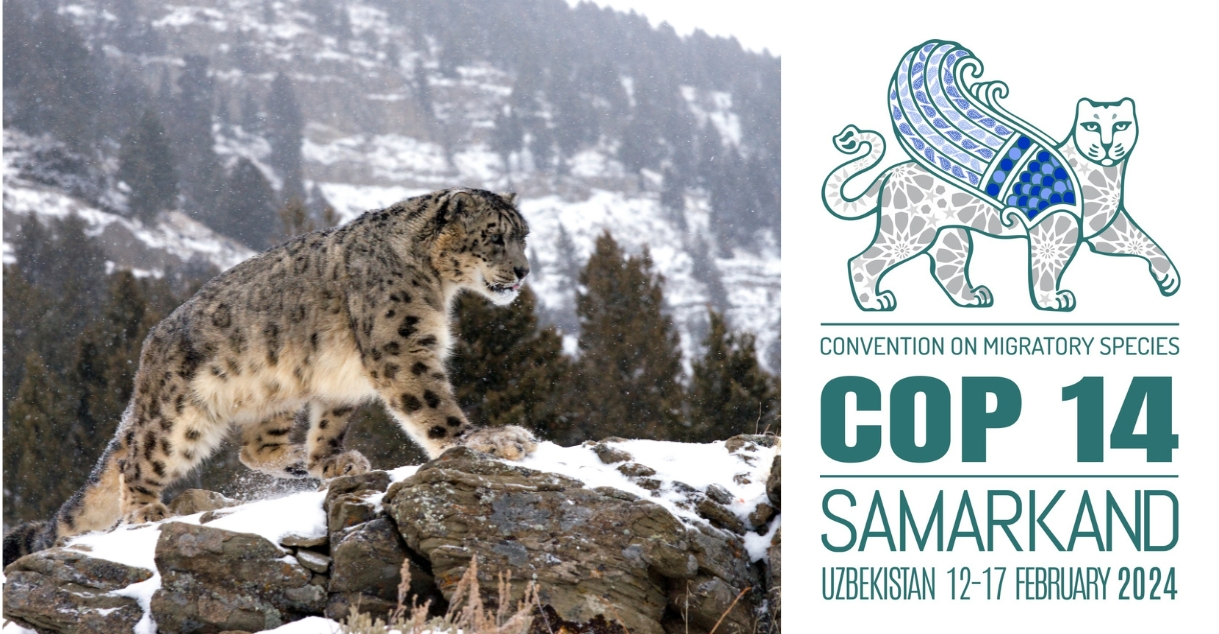Free Courses Sale ends Soon, Get It Now


Free Courses Sale ends Soon, Get It Now



Copyright infringement not intended
Picture Courtesy: https://www.cms.int/en/news/official-logo-and-slogan-announced-14th-meeting-conference-parties-convention-migratory-species
Context: The 14th Meeting of the Conference of the Parties to the Convention on the Conservation of Migratory Species of Wild Animals (CMS COP14) concluded successfully with significant progress made in protecting diverse migratory species.
Details
Outcomes
|
Species |
Origin |
Migration Area |
IUCN Status |
Threats |
|
Eurasian Lynx |
Europe & Central Asia |
Fragmented across Scandinavia, Carpathians, Russia |
Least Concern
|
Habitat fragmentation, human-wildlife conflict, hunting |
|
Peruvian Pelican |
Coastal waters of Chile, Ecuador, Panama |
Breeds on islands off Peru, migrates north along Pacific coast |
Near Threatened
|
Bycatch, disease outbreaks, El Niño events impacting prey |
|
Pallas's Cat |
Central Asia |
Fragmented across grasslands, steppes, mountains in Kazakhstan, Mongolia, Russia, Turkmenistan |
Near Threatened |
Habitat degradation, illegal trade, prey decline |
|
Guanaco |
Arid & semi-arid regions of South America |
Ranges from Ecuador & Peru south through Argentina & Chile |
Least Concern |
Habitat fragmentation, fencing, oil & gas development, illegal hunting |
|
Laulao Catfish |
Amazon River basin |
Long distances within basin for spawning & feeding |
Least Concern
|
Overfishing, habitat degradation from dams & deforestation |
|
Balkan Lynx |
Balkan Peninsula |
Fragmented populations in North Macedonia, Albania, Greece |
Critically Endangered
|
Habitat loss, poaching, roadkill |
|
Lahille's Bottlenose Dolphin |
Coastal waters of Argentina, Brazil, Uruguay |
Primarily coastal, some movement between countries |
Vulnerable |
Bycatch, habitat degradation, pollution |
|
Harbour Porpoise |
Coastal waters of Europe, North America, Asia (focus on "Baltic Proper" population) |
Varies by region, some long-distance migrations |
Least Concern
|
Bycatch, underwater noise pollution, habitat degradation |
|
Magellanic Plover |
Southern South America |
Breeds in Argentina & Chile, migrates north to Peru & Brazil |
Near Threatened
|
Habitat loss, human disturbance, predation |
|
Bearded Vulture |
Mountain ranges in Southern Europe & Africa |
Breeds in mountains, long-distance migrations for food |
Near Threatened |
Poisoning, power line collisions, food scarcity |
|
Blackchin Guitarfish |
Tropical & subtropical waters worldwide |
Primarily coastal, some movement between regions |
Critically Endangered |
Bycatch, habitat degradation |
|
Bull Ray |
Tropical & subtropical waters worldwide |
Coastal & pelagic, some movement between regions |
Critically Endangered |
Bycatch, habitat degradation |
|
Lusitanian Cownose Ray |
Eastern Atlantic Ocean & Mediterranean Sea |
Coastal & pelagic, some movement between regions |
Critically Endangered
|
Bycatch, habitat degradation, pollution |
|
Gilded Catfish |
Amazon & Orinoco River basins |
Long distances within basins for spawning & feeding |
Vulnerable |
Overfishing, habitat degradation from dams & deforestation |
Significance
Conclusion
Must Read Articles:
CMS COP14: https://www.iasgyan.in/daily-current-affairs/cms-cop14
|
PRACTICE QUESTION Q. Climate change and other global environmental challenges introduce significant uncertainties into ecosystem management. How to develop adaptive and flexible conservation strategies that are resilient to future changes and incorporate new scientific understanding as it emerges? Answer Structure: ●Start with a brief introduction that defines the key terms and concepts, such as climate change, ecosystem management, adaptive and flexible conservation strategies, resilience, and scientific understanding. ●Provide some examples of the uncertainties and challenges posed by climate change and other environmental factors on ecosystem management, such as biodiversity loss, habitat degradation, invasive species, natural disasters, etc. ●Explain why adaptive and flexible conservation strategies are needed to cope with these uncertainties and challenges, and how they differ from conventional or rigid conservation approaches. Mention some of the principles and features of adaptive and flexible conservation, such as learning by doing, stakeholder participation, adaptive governance, scenario planning, etc. ●Discuss how adaptive and flexible conservation strategies can enhance the resilience of ecosystems and human well-being in the face of future changes and uncertainties. Provide some evidence or case studies of successful or promising examples of adaptive and flexible conservation in different contexts or regions. ●Conclude with a summary of the main points and some recommendations or suggestions for improving or implementing adaptive and flexible conservation strategies in India or globally. |
© 2024 iasgyan. All right reserved